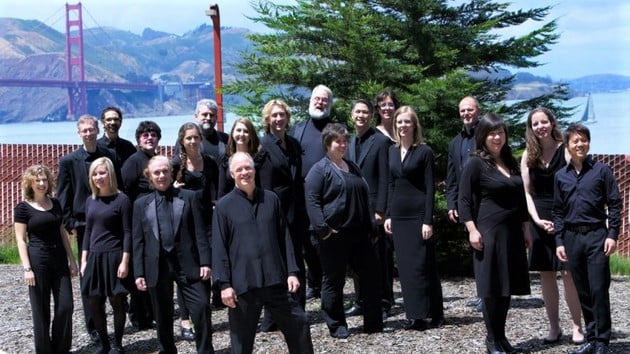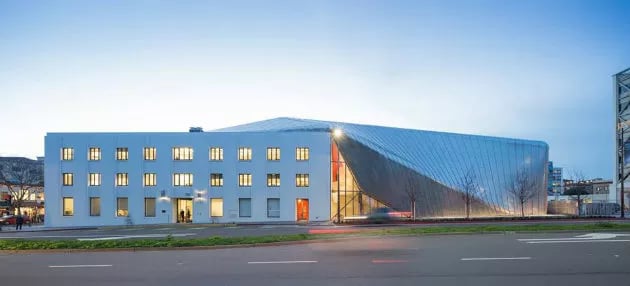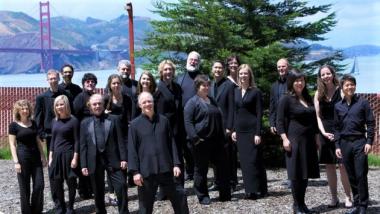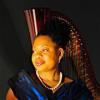
A bustling museum might sound like an acoustically polluted, distracting place for a choral concert. But this atmosphere is exactly what made Volti’s Sunday afternoon concert, conducted by Music Director Robert Geary, come alive.
Guests wandered through the performance space at the UC Berkeley Art Museum and Pacific Film Archive (BAM/PFA), the museum’s large glass doors accompanied each new visitor with a resonant click, there was audible conversation from just behind the audience at the ticket counter. We sat in a deeply descending set of oversized, wooden stairs with a colorfully-painted, two-story high mural of four faces on our right, a set of large windows looking onto Center Street on the left, and above the performance space, a set of paths to galleries and the museum store.
Two delightful things happened because of this setting. First, I had to put increased, focused effort into listening. Rather than being easily engulfed in traditionally beautiful and resonant human harmonies, the situation offered a different, equally or more rewarding opportunity for heightened engagement. This mental state was something like being swooped up into another dimension by the ensemble.
But the second wonderful thing about the space was its awesome connection to the quotidian events of the museum: the muffled chatter of art viewers, the occasional and pleasant clamor of children, or surprised museum guests unexpectedly wandering into the performance space. This created a perhaps paradoxically engrossing distancing effect, where the compositions seemed to float in a bubble right in front of the audience, entrancingly reflecting light.

These dynamics of focus and perceptual distance worked wonders for the premiere of Žibuoklé Martinaityté’s (zhih-BWAH-kleh martin-ay-TEE-teh) Chant des Voyelles (Incantation of vowels). Despite the publicly expressed concerns about the work’s viability in the space, Martinaityté’s composition, made up almost entirely of vowel sounds, was breathtaking. The subtly shifting transformation of vowels was the sonic equivalent of cirrus uncinus clouds, wisped and unusual. And Martinaityté’s music, like an extension of Arvo Pärt’s musical language, especially in the slowly mutating ostinati at the end of the piece and her deeply effective use of form, were profoundly moving.
The space worked hand in hand with Danny Clay’s Playbook Choruses, especially #3. Here, Volti’s conductor and 16 members were divided into three groups: one in the performance space at the bottom of the large wooden stairs; another halfway up into the seating area, close to the mural; and another immediately behind the audience. Each group had what looked like a wooden comb and the inside mechanism of a music box. Singers droned, changing pitch from time to time while one performer from each group elicited clicks by slowly plucking the comb’s teeth. Another performer glacially turned the music box’s crank, generating gently quiet pitches irregularly unfolding. The distancing effect of the space combined with the quiet instrument timbres and angelic drones was surprisingly riveting, maybe something like the experience of ASMR.

Clay’s other two works operate like sonic improv theater exercises. The first had Geary facing the audience with choir members planted throughout the audience. Gestures and cues, from eye glance direction to degrees of slouching, coded rising pitches, shushing noises, shouts, and more from the choir and, frequently, surprise and friendly laughter from the audience. The second piece was a game where all the choir members formed a circle and went around the circle, each making a unique sound. A handclap from a choir member changed the direction which, because of the group’s rapid tempo, led to errors. The group decided who was to blame, and they left the circle with a communal sound and double clap.
This may sound child-like or even childish, and the pieces do originate from Clay’s work as a music teacher. But neither the resulting sounds nor the musical rules for play are simple or uninteresting. In fact, the joy of listening was multiplied as we worked to understand the internal logic of the piece (how the sounds are made), while also enjoying the improvised sounds themselves.
In total, Volti brought the works of four living composers to life, and three of them were in the audience. So if you are looking for interesting and moving new music, impeccably performed, keep tabs on Volti.




